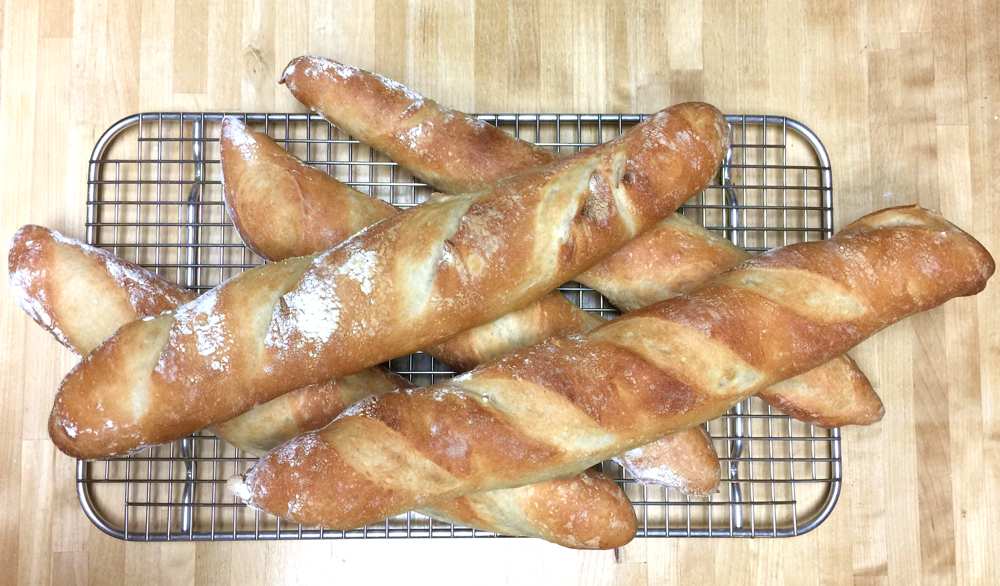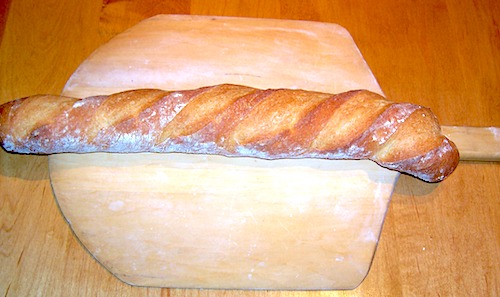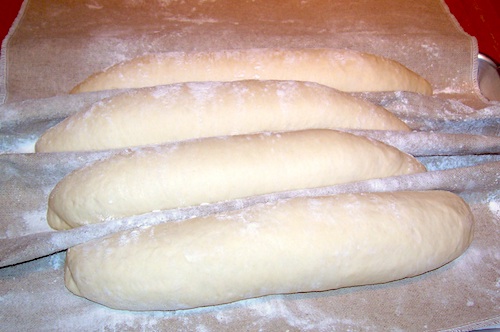
I get many questions regarding my video and recipe on how to make French bread. I have posted some of them below. This article will be a work in progress as I intend to regularly add information to it.
Please keep in mind that some things are difficult to learn online and that I hope some of you reading this will have the opportunity to learn in person how to make French Bread and many other complicated foods in a live setting. I would suggest making pizza out of my pizza dough before attempting French bread as it will be less frustrating, but still delicious!

Please check my articles on How Long Does It Take Dough To Rise and Pizza Dough FAQS for more useful information on making yeast doughs.
How do you create steam in the oven?
I keep an old metal pan on the bottom of my oven. It’s actually a baking pan from a previously used toaster oven. I have used an old cookie sheet, too. The pan will not be usable for any thing else once you use it for making steam. I let the pan preheat in the oven along with my stone. As a matter of fact, I just leave mine in the oven all of the time. When the loaves are ready to bake, I place them on the stone and quickly pour about 1/2 cup boiling hot water into the pan which creates a bunch of steam. I then immediately close the oven door. The steam helps the loaves to rise more in the oven and aids in crust development. This may or may not be a good idea in your home oven. I would not recommend this method if you have an electric oven, as there as there are electric elements on the floor of the oven. With an electric oven, it may work to place the pan on a rack below your stone. Please use caution and remember that the steam is very hot! Also, keep in mind that you are putting a lot of moisture in your oven that could cause things to rust. Please use this method at your own risk.
Can the sponge be proofed for a longer time, perhaps overnight?
Yes, you can ferment the sponge longer. You can use less yeast or for a slower ferment or place the sponge in a cooler location or a combination of both methods. Keep in mind that a long fermentation may create a sort of sour dough – it can be delicious, but a little different. You may need to experiment to find what works best for you. My recipe is a good one to play around with since some new yeast and food is put into the dough after the initial fermentation.

What about the cloth (baker’s couche) that you use to proof the loaves of bread before baking?
This material is 100% untreated, unbleached linen (made from flax fibers). I purchased mine from King Arthur Flour, but it came with raw edges that were unraveling a bit, so hemmed it (actually my Mom did the sewing) with a serger sewing machine. It is not supposed to be washed as the material will lose it’s natural non-stick properties therefor, it should only be used for leans doughs (no fat, dairy or eggs). I have experimented with duck cotton canvas that I purchased at a fabric store. It works fairly well and can be washed, but it is not as stiff as the couche and you may need to use more flour to prevent sticking.
The purpose of proofing the breads this way is that the fabric gently holds the dough in the baguette shape, allowing it to rise upwards, rather than spreading out. The natural oils in the couche also help prevent the dough from drying out, however I often put a sheet of plastic over the dough to give it extra protection. If you want to simulate a couche without spending any money, I have had luck using an old, clean cotton tablecloth, double or quadruple folded for sturdiness.
Why doesn’t my French bread come out like yours?
It is impossible for me to completely address this question in a virtual world. While French bread is made from simple ingredients, the process of making, shaping and baking the dough has many places where mistakes can be made. The most difficult part of bread making for most of my students is in the proper shaping of the dough, especially the need to make the loaves nice and tight before their final proofing. It may take some time to get the technique down, so keep trying and be patient. After all, bread isn’t that expensive to make, so practice away! In addition, French bread is one of the more difficult breads to make, because is is made with a very lean dough – a dough containing no fat. A lean dough has a tendency to quickly form a crust in the oven, preventing the bread from achieving “oven spring or rise” giving lightness and a lovely crust to the bread. Following all of the steps properly will help.
Can I refrigerate the shaped loaves and bake the following day?
Once the dough has been shaped into loaves, it is best to proof and bake right away. If you want to bake on the following day, store the dough in the refrigerator after it has risen (after Step 5 – recipe on my web site). For the overnight method, don’t let the dough rise until fully doubled in volume, because it may get over fermented. It will continue rising in the refrigerator, only more slowly.
Can I use instant yeast or fresh yeast instead of active dry yeast?
You can use fresh yeast, about .25 ounces (about 1.25 teaspoons or 6 ml) each for the sponge and then the dough (total of 0.5 ounces). Instant yeast would be OK, but it is usually the fast rising kind which I don’t like. Fast is not better when it comes to French bread.
Why don’t you use oil in your dough?
Oil will change the texture of the bread (especially the crust) and is not a traditional component of French Bread. You do not need to coat the bowl with oil before placing the dough to rise. It’s actually beneficial for the dough to be able to grab onto the sides of the bowl when expanding. It’s easier to make breads that contain oil, because the dough’s surface doesn’t dry out as quickly in the oven. If you’re making French Bread at home- you’re not into “easy” to begin with, right?
How can I stop my bread from drying out quickly?
I always bag and freeze all but the loaves that we’re going to eat right away. Lean breads, like French bread, tend to dry out quickly. You can freshen them up by heating in a 350-400F oven. They’ll get crispy on the outside with a moist interior.
Happy Baking!

why my french bread never comes out with so big holes? 🙁
It's hard to say, but perhaps the dough wasn't proofed long enough before baking. Also the crust may have dried in the oven before it had a chance to rise (oven spring). Good luck!
Just made it! OMG, it came out perfect. Thank you!
Great to hear! Congrats.
Hello Susan, I have questions about the french bread:
how much time you leave between the time or you shape the bread and the placing in oven?
Why when I discover my bread shaped it collapses? Thank You! For all … a p'tit french
The time that it takes for the loaves to rise after shaping depends greatly on your room temperature. It could take any where from 30-90 minutes. Test it by the finger indentation method shown in the video. A couple of reasons for dough collapsing could be that it was left to rise for too long and/or the gluten wasn't developed enough. Good luck!
the ingredients say use 10 oz or 2 cups for the sponge, but 2 cups equal 16 oz, why the difference and what should I use?
thanks,
Dave- I'm sure that you are not the only one confused by this!
2 cups equals 16 fluid ounces which is a measurement of volume as opposed to weight. In the case of water or other liquid that has a similar density (like milk), 16 fluid ounces does equal(approximately) 16 ounces by weight. However, with flour this is not the case. Flour is much lighter per unit of volume than most liquids, therefore 2 cups of bread flour is approximately 10 ounces by weight. It is best to weigh the flour in my bread recipes. To see why, watch my little video on the subject here. Happy Baking!
Thank you for the great video! I'm making french bread but I only have regular flour. My sponge doesn't look as thin as the one in the video. Do I use the same amounts of regular flour as bread flour?
Thanks!
Erika
Please check out my Pizza Dough FAQs page for info on both flours. All purpose flour, though, should not make a thinner sponge. Weigh flour for best results. Good luck.
Thank u for this great recipe my bread came out good!
Is it ok if I don't dilute the yeast the second time? Would it ruin the bread?
1 cups of warm water refers to 250ml ? is it correct?
Do you have a recipe that is for one loaf? We love french bread but there is only 2 of us and we cant eat that much bread?
I have a cass iron griddle. Would that work for a baking stone?
You can use cast iron plus other methods. Please view my No Pizza Stone, No Problem! page.
Thanks Susan! Your recipe and technique are foolproof if followed to the letter. The bread is delicious. Merci…
Happy for your success!
Is it possible to freeze the dough after shaping it? I was hoping to do a big batch to freeze and cook individually when needed.
I wouldn't recommend freezing the dough.I would make the bread and freeze the loaves.
Hi Susan,
I followed the exact steps to your recipe, including steaming and squirting the loafs. I ended up with a very tasty bread with a nice crust and crumb.
The only issue i had was the color..Unlike your bread, mine was much paler then i would have liked it to be. I live in a very warm country, and the room temp at which i let the bread proof/rise was about 86-92 F. Could that be the reason? Should i scale down the yeast?
Regards,
Ali
Yes, the warm temperature may have caused the dough to over ferment using up all available sugars in the dough. Try using cooler water and putting the rising dough in the refrigerator to cool down to 80F, if necessary. It may take some experimentation. You can try reducing the amount of yeast, but you still need to cool down your dough. Some bakeries even use ice water to reduce the dough temperature which can increase due to the friction of mixing.
Thanks Susan.
I tried to use cooler water and kept the dough in an air conditioned room, the temp was around 79-81 Degrees.
I used the same amount of yeast and followed through with the recipe. Unfortunately though I still couldn't get my loafs to brown. My results were the same as last time. A tasty but rather pale bread.
I do not own a pizza stone, so preheated my oven and placed the bread on my preheated cookie sheets. Maybe I should brush them with egg whites or egg yolks before putting them in the oven next time.
Regards,
Ali
This comment has been removed by the author.
This comment has been removed by the author.
This comment has been removed by the author.
why did my bread came out hard? i used bakers corner, all purpose flour and fast rising yeast the same amounts you used!
I just followed your recipe to the letter and was pleasantly surprised with the outcome! I didn't want to end up with waste in case it didn't turn out so I made half the recipe and regretted not making more 🙂
I did find it hard to slice the bread before the oven bake (knife had a hard time cutting thru). If there's a tip for this step please let me know.
Thanks again for the great video and recipe.
Chezvill, California